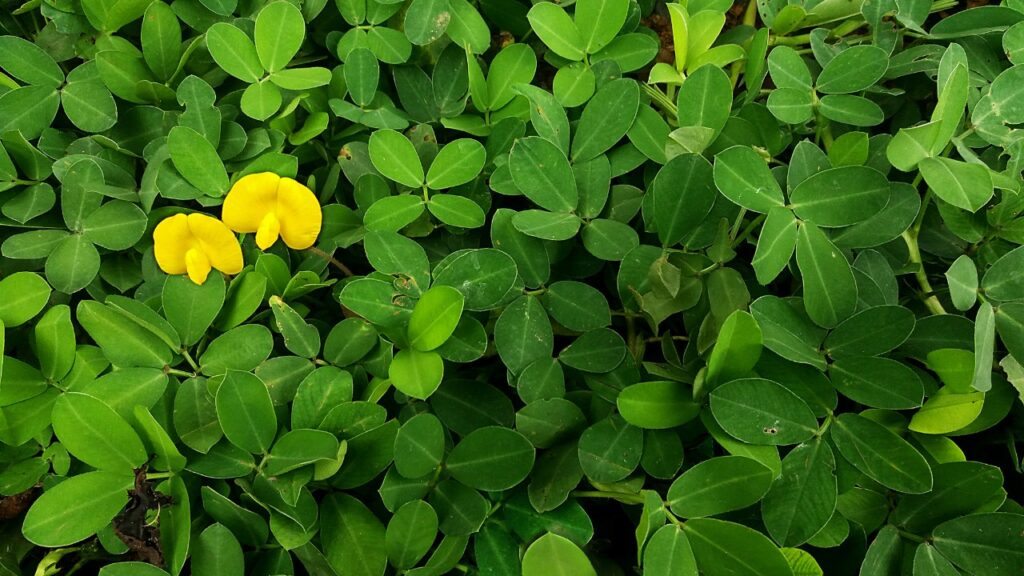The peanut grass (Arachis repens), also known as creeping peanut, is an ornamental ground cover native to Brazil, widely used in landscaping and soil restoration. It has gained popularity mainly for forming dense carpets, requiring minimal mowing, and improving soil quality. In addition to being used as ground cover in urban areas, gardens, and orchards, this species also has significant potential for preventing erosion on slopes and steep terrains, thanks to its rapid growth and an efficient root system that stabilizes the soil.
Although very similar to forage peanut (Arachis pintoi), it is a distinct species. Despite being referred to as “grass,” it is not a true grass, as this classification is exclusive to species belonging to the Poaceae family. However, since it is one of the few ground covers that form a dense mat and tolerate foot traffic like a true grass, it has earned its popular name and reputation.
The genus name Arachis is derived from the Greek arachis, meaning “leguminous plant,” while the specific epithet repens refers to the plant’s creeping habit, characterized by its prostrate growth and stolon formation.
Peanut grass is native exclusively to Brazil, particularly the state of Minas Gerais, where it thrives in Cerrado environments, often in open areas near watercourses. Despite its naturally restricted distribution, the plant has been widely introduced to other regions of Brazil and abroad, including neighboring South American countries, the United States, and some areas in Africa. Its adaptability to different environmental conditions has facilitated its use across various Brazilian biomes, including the Amazon, Cerrado, Atlantic Forest, and Pampas, in both natural areas and urban gardens.
Peanut grass is a low-growing, herbaceous perennial that typically reaches heights between 4 and 10 inches (10 and 25 cm), depending on growing conditions. Its root system is deep for a creeping species, extending up to 12 inches (30 cm), which enhances its drought resistance and soil stabilization capabilities. The primary roots are axial and simple, with secondary branching. The plant features stoloniferous stems, meaning it develops long, horizontal stolons that spread across the soil, rooting at nodes as they extend. This growth habit enables rapid propagation and high-density coverage, forming a uniform carpet. The stems are thin, long, and flexible, lacking rhizomes, and bear compound leaves arranged alternately along the stolons.

The leaves of Arachis repens are compound and tetrafoliolate, meaning each leaf comprises two pairs of oppositely arranged leaflets. The leaflets are pinnate, oval-shaped with rounded tips, exhibiting a deep green hue and a slightly hairy texture on the underside. Its dense growth contributes to forming a compact vegetative cover, effectively suppressing weed growth.
The inflorescence of peanut grass is axillary and multiflorous, meaning it emerges from the leaf axils and can produce multiple flowers. The flowers are small, hermaphroditic, and predominantly yellow, though in rare cases, they may have an orange-hued banner petal. The floral structure follows the typical legume pattern, with a broad, slightly striated banner petal on the adaxial side, smaller lateral wings, and a subtly hairy calyx. Flowering occurs year-round, particularly in warm and humid climates, attracting pollinators such as bees and small beetles.
Just like the common peanut (Arachis hypogaea), the fruits of peanut grass develop underground. After pollination, the ovary elongates and grows toward the soil, burying itself for fruit development. The fruit is an articulated lomento, with an isthmus separating the segments that contain the seeds. The pericarp is smooth and relatively thin, with each fruit segment containing a single seed. This geocarpy mechanism, characteristic of the Arachis genus, limits natural seed dispersal but allows regeneration after heavy foot traffic, grazing, or even fire, as it forms a seed bank beneath the soil.
Peanut grass has the ability to improve soil quality since, as a legume, it forms a symbiotic relationship with nitrogen-fixing bacteria, enhancing soil fertility without the need for intensive chemical fertilization. This trait, combined with its ability to suppress weeds and tolerate partial shade, makes it a preferred ground cover in orchards. Due to its high protein content, it is also valued as forage, though forage peanut is generally preferred for this purpose.
In landscaping, Arachis repens is widely used as ground cover in areas with low foot traffic, serving as an excellent alternative to traditional lawns. Although it tolerates foot traffic and regenerates vigorously, it tends to appear flattened and disheveled, diminishing its aesthetic appeal. Its ability to cover the ground quickly with minimal maintenance makes it an ideal choice for residential gardens, urban flower beds, slopes, embankments, and large-scale applications in parks, residential landscapes, and public spaces. It is frequently used in orchards and among ornamental plants, protecting the soil from erosion and aiding in moisture retention, in addition to offering ornamental value with its delicate yellow flowers contrasting against the lush green foliage.
Peanut grass thrives in full sun but tolerates partial shade. Its optimal growth occurs in tropical and subtropical climates. It adapts to a wide range of temperatures but may experience reduced growth in regions with harsh winters, where extreme cold can cause partial leaf loss. It does not tolerate frost, as the foliage burns in such conditions, but it can regrow after pruning. It prefers well-drained, deep, and fertile soil but grows well even in poorer soils, provided there is a minimum amount of organic matter and adequate moisture. Its adaptability to various soil types makes it an excellent option for environmental restoration and erosion control.

Peanut grass requires regular irrigation during the first few months after planting to ensure proper establishment, but once rooted, it exhibits good drought resistance. An initial application of organic matter is recommended to stimulate growth, and occasional use of slow-release fertilizers can aid in maintenance. However, due to its nitrogen-fixing ability, frequent fertilization is unnecessary. Maintenance is minimal, as it does not require regular mowing—its creeping habit prevents excessive growth. In some cases, a light trimming may be beneficial to encourage renewal and denser foliage.
Regarding pests and diseases, peanut grass is highly resilient. Due to its hardiness, it rarely suffers from severe issues. Proper soil drainage and adequate ventilation help prevent fungal diseases that may arise in excessively humid environments. Occasionally, it may be affected by mites, leaf miner caterpillars, scale insects, aphids, caterpillars, leaf-cutting ants, thrips, nematodes, borers, and stink bugs. One potential drawback is that it may attract hares.
Peanut grass can be propagated through seeds, stolon cuttings, or most commonly, by dividing rooted branches. This method ensures rapid and effective ground coverage. Propagation by seeds is uncommon, except for seed producers, as harvesting them is challenging and requires soil disturbance.


